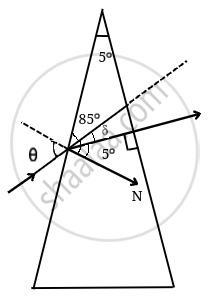Advertisements
Advertisements
प्रश्न
A ray of light incident at an angle θ on a refracting face of a prism emerges from the other face normally. If the angle of the prism is 5° and the prism is made of a material of refractive index 1.5, the angle of incidence is ______.
पर्याय
7.5°
5°
15°
2.5°
उत्तर
A ray of light incident at an angle θ on a refracting face of a prism emerges from the other face normally. If the angle of the prism is 5° and the prism is made of a material of refractive index 1.5, the angle of incidence is 7.5°.
Explanation:
In thin prisms, the distance between the refracting surfaces is ineligible and the angle of prism (A) is very small. Since A = r1 + r2, therefore if A is small then both r1 and r2 are also small, and the same is true for i1 and i2.

A = 5°
μ = 1.5
i2 = 0°
r2 = 0°
r1 + r2 = A
r1 = A - r2 = 5 – 0 = 5°
μ = `(sini1)/(sinrlμ) = (sinil)/(sinrl)`
⇒ `sini1 = μsinr1`
= `1.5 xx sin 5°`
= 1.5 xx 0.087`
= 0.1305
= 7.5°
APPEARS IN
संबंधित प्रश्न
What is total internal reflection?
Prove the statement.
A rainbow is the combined effect of the refraction, dispersion, and total internal reflection of light.
Swarali has got the following observations while doing an experiment. Answer her questions with the help of observations.
Swarali observed that the light bent away from the normal, while travelling from dense medium to rarer medium. When Swarali increased the values of angle of incidence (i), the values of angle of refraction (r) went on increasing. But at a certain angle of incidence, the light rays returned into the dense medium.
So, Swarali has some questions. Answer them –
a) Name this certain value of ‘i ’. What is the value of ‘r’ at that time ?
b) Name this process of returning of light in dense medium. Explain the process.
Total internal reflection can take place only if ______.
Why do diamonds sparkle?
Images formed by totally reflecting prisms are brighter than the image formed by ordinary reflected light, why?
What is meant by the term ‘critical angle’?
Solve Numerical example.
From the given data set, determine angular dispersion by the prism and dispersive power of its material for extreme colours. nR = 1.62 nV = 1.66, δR = 3.1°
The twinkling effect of star light is due to ______.
The critical angle is defined as the angle of incidence at which the total internal reflection starts to occur.
